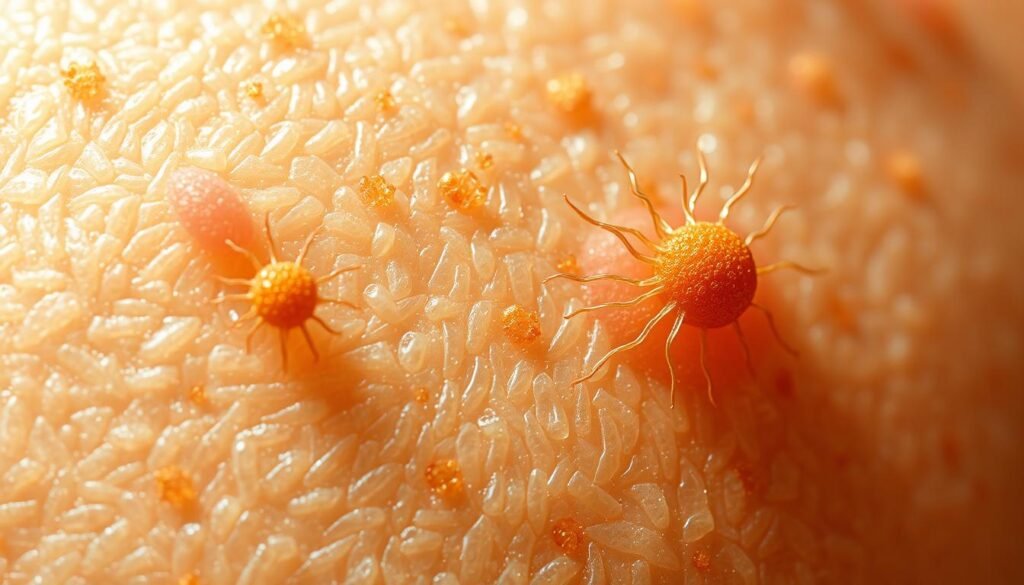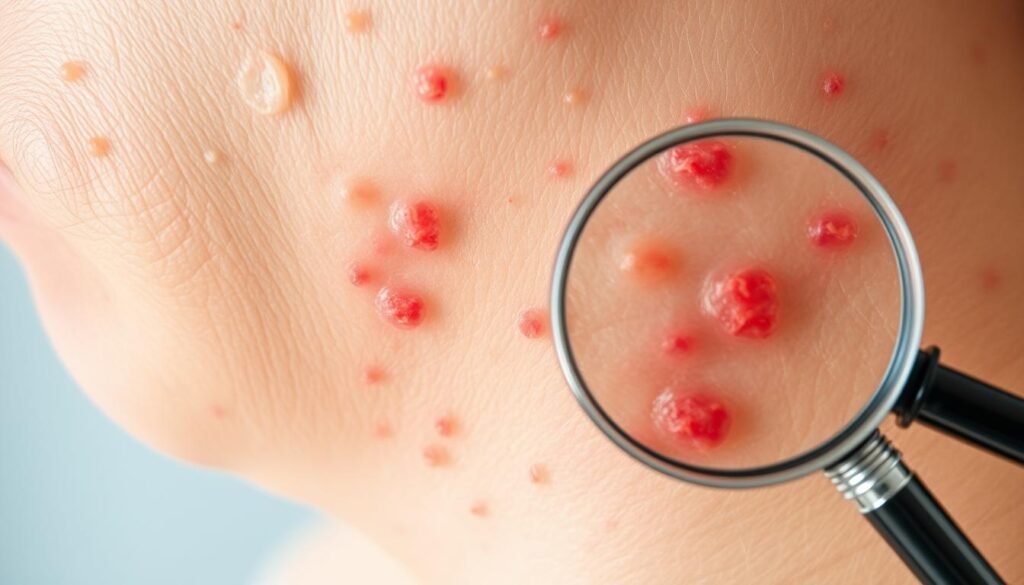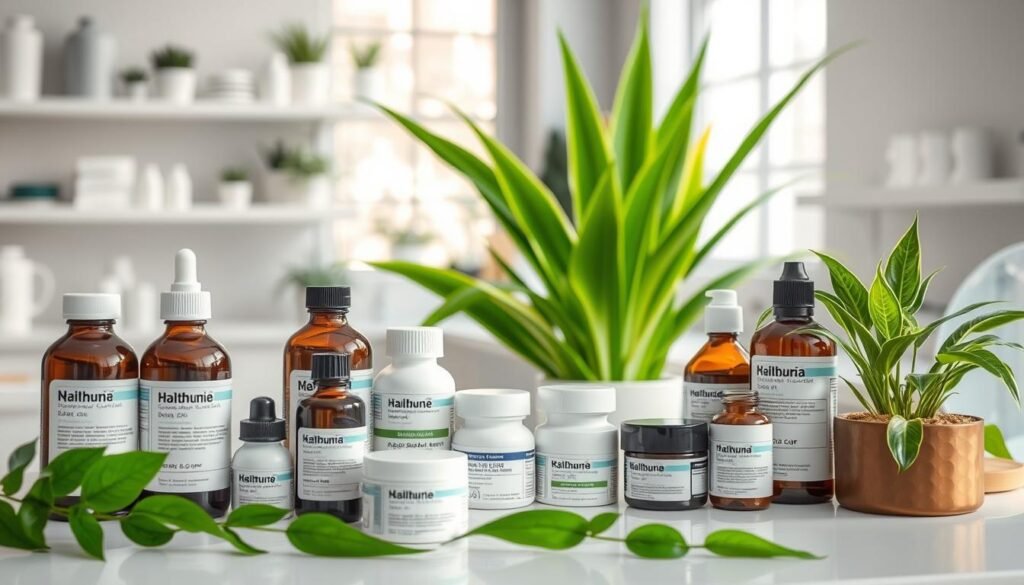About 1% to 3% of people suffer from seborrheic dermatitis, linked to Malassezia overgrowth. Around 4% of people seen in dermatology clinics have Malassezia folliculitis. This mostly affects adolescents and young adults, with an average age of 26. These numbers show how Malassezia yeasts can significantly affect skin health.
Malassezia’s overgrowth can cause various skin problems, including fungal infections and seborrheic dermatitis. It’s vital to tackle these yeast challenges to improve skin health. This article will look at effective treatments, mainly antifungal therapies. These treatments are crucial for controlling Malassezia overgrowth. Readers will learn about the medications available in the United States that can help heal and provide relief.
Key Takeaways
- Malassezia overgrowth can significantly impact skin health, causing conditions like seborrheic dermatitis.
- The incidence of Malassezia folliculitis is notable among young adults, with an average age of 26.
- Effective treatment options, including topical and oral antifungal medications, play a vital role in managing symptoms.
- Understanding the prevalence and symptoms of Malassezia overgrowth is essential for timely intervention.
- Antifungal therapies are crucial for effectively treating skin issues associated with Malassezia yeasts.
Understanding Malassezia Overgrowth
Malassezia overgrowth happens when the normal Malassezia yeasts on our skin grow too much. These yeasts are usually harmless and live on our skin. But if conditions like high humidity, too much oil, or a weak immune system happen, these yeasts can cause skin problems.
This issue is a part of a bigger picture called Understanding Fungal Infections. It looks at different fungal infections that can hurt our skin health. When our skin’s good microbes get out of balance, the risk of getting infections goes up. This is more common in people with allergies or certain skin conditions.
Not just humans, but animals, especially dogs, can get Malassezia yeast infections too. Some dog breeds like West Highland White Terrier and Cocker Spaniel are more likely to get these infections. Dogs that have weak immune systems or are on certain medicines might have more yeast problems. Knowing this helps us see how common Malassezia overgrowth is.
- Presence in various skin regions, contributing to an overall fungal population of approximately 30%.
- Identification in diverse locations, such as human breast milk and gut microbiomes, highlighting its various roles.
- Challenging management in animals, requiring consistent veterinary intervention for underlying causes.
- Notable significance in skin health, as overgrowth can lead to conditions like dermatitis.
Knowing about Malassezia overgrowth is key to understanding how it affects our skin health. Keeping these yeasts in balance is crucial for preventing skin issues and keeping our skin healthy.
| Factor | Role in Malassezia Overgrowth |
|---|---|
| High Humidity | Promotes yeast proliferation |
| Excess Oil Production | Provides nutrients for yeast growth |
| Immunosuppression | Decreases the body’s ability to control yeast levels |
| Genetic Predisposition | Increases susceptibility in certain dog breeds |
| Underlying Skin Conditions | Encourages recurrent overgrowth due to compromised skin health |
The Role of Malassezia Yeasts in Skin Health
Malassezia yeasts are key to healthy skin. They are a natural part of the skin’s flora, helping maintain skin health. These yeasts feed on the lipids in sebum, which helps them grow. Keeping Malassezia in balance is critical to avoid skin problems. Too much of these yeasts can cause inflammation and infections.
The impact on skin health is huge. Too much Malassezia can lead to seborrheic dermatitis and fungal acne. About 3-5% of people worldwide suffer from seborrheic dermatitis. That’s between 200-350 million adults. This condition is even more common in those with weak immune systems, affecting up to 80% of HIV-infected individuals.
Pityriasis versicolor is another issue tied to Malassezia. It’s often seen in warmer climates. Up to half of the adults in these areas may be affected. The condition often comes back, so ongoing treatment is needed to keep it under control.
It’s crucial to keep the skin’s flora balanced. Treatments like topical imidazole help control seborrheic dermatitis. They bring back a healthy balance among the skin’s microbes. Learning about Malassezia’s role in the skin helps us understand its effects on our health. As research progresses, our knowledge about Malassezia and its broader impacts continues to grow.

For more details on Malassezia in the human body, visit this resource.
Symptoms of Malassezia Overgrowth
Malassezia overgrowth shows up in many ways, which include itchy red bumps. They mostly appear on the chest, back, and face. This fungal issue can irritate the skin. So, it’s important to spot these signs early.
It’s common to mix up fungal acne symptoms with regular acne’s signs. But, Malassezia infections cause bumps that look alike in size and shape. Also, you might feel a strong itch, showing it’s a fungal issue, not just acne.
To treat this well, knowing the difference is key. If you have these fungal acne symptoms, check out effective ways to manage it. For tips and treatments, see this useful article.
| Symptom | Description |
|---|---|
| Itchy Red Bumps | Small red lesions often present in clusters. |
| Papules | Raised, inflamed spots on the skin that may be painful. |
| Pustules | Fluid-filled bumps that can appear on the face, chest, and back. |
| Pruritus | Intense itching often accompanies the lesions. |
Spotting these signs early helps in finding the right treatment quickly. Dealing with skin irritation properly returns skin to health and comfort.
Diagnosing Malassezia Folliculitis
Diagnosing Malassezia folliculitis is tough because it looks a lot like acne. You’ll see red bumps and pustules on oily parts of the body like the back, chest, and shoulders. It’s often found in people with weak immune systems or those who’ve recently been on antibiotics. So, a careful skin examination is key.
Doctors use different diagnostic tests to tell this condition apart from acne. They might look at skin scrapings under a microscope to spot yeast. Culture tests help confirm it, making sure they know it’s this fungal infection for sure.
Seeing how the skin gets better with antifungal drugs is a big hint. If there’s clear improvement after starting treatment, it likely means pityrosporum folliculitis is present. Checking how the symptoms change is important to make sure the treatment is working right.
Lifestyle and past medicines also get looked at when diagnosing. Knowing these things helps doctors figure out the best way to treat pityrosporum folliculitis.

| Diagnostic Technique | Purpose | Considerations |
|---|---|---|
| Microscopic Evaluation | Identify yeast presence in skin scrapings | Requires skilled personnel |
| Cultural Tests | Confirm presence of Malassezia spp. | May take time to yield results |
| Symptom Assessment | Track changes in skin condition | Response to antifungal treatment is key |
Medication and Malassezia Overgrowth Management
Dealing with Malassezia overgrowth involves personalized medication plans. Combining Topical Medications and Oral Antifungals brings great outcomes. This approach eases symptoms and betters skin health. Knowing about these treatments helps pick the right one for you.
Topical Medications
Malassezia Overgrowth Treatment relies a lot on topical solutions. Doctors often suggest using ketoconazole or clotrimazole. Ketoconazole is especially good for tackling conditions like seborrheic dermatitis. You can use these meds on the problem spots. They come as creams, gels, or shampoos.
- Ketoconazole: Commonly used for seborrheic dermatitis and other fungal infections.
- Clotrimazole: Another effective option that acts against fungi.
- Tea tree oil shampoo: With a 5% concentration, it can be left on the scalp for 3-10 minutes to treat symptoms.
- Quassia extract gel: A 4% gel can be applied once or twice daily as an alternative treatment.
- Aloe vera gel: Can be used multiple times a day to help alleviate symptoms.
- Avocado oil: Assists in scale removal and has antifungal properties.
Oral Antifungals
In severe cases, doctors might prescribe Oral Antifungals, like fluconazole. Users often see quick relief. These meds work through the body, fighting the fungal growth more thoroughly than topical treatments.
When we compare, both topical and oral treatments have their special roles. They work against Malassezia Overgrowth in different ways.
| Treatment Type | Examples | Application Method | Effectiveness |
|---|---|---|---|
| Topical Medications | Ketoconazole, Clotrimazole, Tea Tree Oil | Applied to affected areas | Effective for localized symptoms |
| Oral Antifungals | Fluconazole | Ingested medication | Rapid improvement in severe cases |

Antifungal Treatments Overview
Understanding antifungal treatments is key for managing Fungal Infection Management. Treatments for Malassezia include both topical and systemic therapies. Each type works differently to fight off infections.
Topical antifungals are often the first choice. Options like topical azoles, chlorhexidine with azoles, and selenium sulfide are popular. Shampoos for fungal infections are typically used 1-2 times a week. They help manage Malassezia dermatitis in pets easily. For tough cases, topical photodynamic therapy may be considered, even though it’s not always effective.
Systemic treatments play a critical role in tougher or recurring infections. Drugs like fluconazole are effective, especially when topical treatments fail. About 71 of 170 patients with AIDS developed Malassezia infections, showing the complexity of Fungal Infection Management. This complexity often requires combining topical and oral medications.
Combining treatment methods helps fight Malassezia effectively, especially in repeat infections. Nearly all Malassezia folliculitis cases get some treatment, highlighting the need for early intervention. This is especially true for kids, who make up about 5.3% of cases.
A comprehensive approach is essential in fighting Malassezia overgrowth. This approach should consider the range of Malassezia Treatment Options and individual patient needs. For more details on Malassezia and its treatment, check this research article.
| Treatment Type | Examples | Use Case | Efficacy |
|---|---|---|---|
| Topical Antifungals | Topical azoles, chlorhexidine, selenium sulfide | Mild to moderate infections | Effective in most cases |
| Systemic Antifungals | Fluconazole | Severe or recurrent infections | High success rate in clinical use |
| Combination Therapies | Topical plus systemic | Recurrent or resistant cases | Increased overall efficacy |
Unraveling Seborrheic Dermatitis and Dandruff
Understanding the link between seborrheic dermatitis and dandruff is crucial. Both issues arise from too much Malassezia yeast. This yeast grows due to oily skin, genetics, and the environment. Knowing the causes of dandruff helps people find relief.
Common Causes and Triggers
About half of all adults get dandruff. It starts in young adulthood and can continue into middle age. Men see it more, likely due to hormones. Diseases like Parkinson’s can also make dandruff more likely. Key factors for dandruff include:
- Not shampooing enough or not using it well
- Changes in weather or humidity
- Stress affecting skin
- Too much Malassezia on the scalp
Even older adults face dandruff, worsened by certain health issues and diets. Less of some vitamins and minerals, like riboflavin, niacin, and zinc, might make seborrheic dermatitis worse.
Preventative Measures for Fungal Overgrowth
Stopping fungal growth is vital for dealing with these scalp problems. A good hair care routine is key. This means choosing the right shampoos and trying natural remedies. Tea tree oil, aloe vera, and apple cider vinegar are popular for their dandruff-fighting properties. Diet also matters. Eating foods high in omega-3s and cutting back on sugar and alcohol can help keep the scalp healthy.
Understanding how lifestyle, diet, and hair care blend together aids in managing seborrheic dermatitis. Right steps not only ease symptoms but also boost skin health.
Ketoconazole: A Key Player
Ketoconazole is an important Key Antifungal Treatment for skin issues, especially from Malassezia overgrowth. It fights fungal infections, helping those with dandruff, athlete’s foot, ringworm, and “fungal acne.” It’s notable that 80% of people with pityrosporum folliculitis feel much itching, showing why managing it well matters.
You can find ketoconazole in creams and pills. The cream form often shows results on “fungal acne” in 1 to 2 months. You can buy some forms without a prescription at pharmacies. Yet, for tough cases, a doctor’s advice is key, showing the need for personalized Malassezia Management.
Most people tolerate ketoconazole well, but there are some side effects. Topical forms can cause itching, redness, or stinging. Pills can lead to nausea, vomiting, belly pain, constipation, and even change the color of your tongue. Knowing these risks helps use it safely.
Research backs ketoconazole as a top choice in Malassezia Management. Learning about its uses and risks lets people take care of their skin better. If you’re looking into scalp flaking and dandruff, check out this useful guide on understanding dandruff causes.
| Formulation | Indications | Time for Improvement | Common Side Effects |
|---|---|---|---|
| Topical | Dandruff, fungal acne | 1-2 months | Itching, redness, stinging |
| Oral | Severe fungal infections | Variable | Nausea, vomiting, dry mouth |
Conclusion
Understanding and addressing Malassezia overgrowth is key for healthy skin. This article highlighted Malassezia’s role, its growth in oily skin areas, and its link to conditions like dandruff. Using treatments like ketoconazole, especially in foam form, can be very effective. Choosing the right treatment enhances the management of fungal issues, leading to improved outcomes.
If you think you have symptoms of Malassezia overgrowth, it’s important to get help. Talking to a healthcare provider can help you find the best way to deal with this issue. They can suggest specific steps to take, especially if you’re prone to skin problems. Knowing what triggers the overgrowth and how to treat it makes prevention and management easier. Education and proactive care are your first steps towards healthier skin.